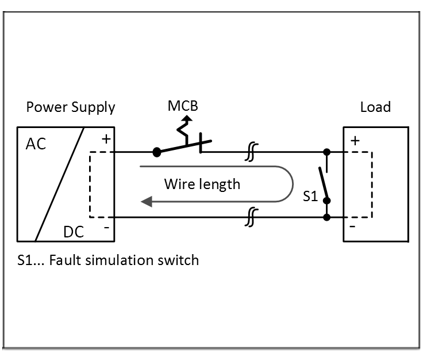Output circuit breakers
Standard circuit breakers (or UL1077 circuit breakers) are generally used for AC supply systems and can also be used for 48V branches.
Circuit breakers are used to protect wires and circuits. If the ampere value and the characteristics of the circuit breaker are matched to the wire thickness used, the wiring is considered thermally safe, regardless of whether the circuit breaker opens or not.
To avoid voltage drops and situations with undervoltage in adjacent 48V branches fed from the same source, a fast (magnetic) trip of the circuit breaker is desirable. Fast switch-off within 10ms is required, which approximately corresponds to the bridging time of PLC. This requires power supplies with high reserve current and large output capacitors. In addition, the impedance of the faulty branch must be sufficiently small for the current to actually flow. The strongest power supply is of no use if the ohmic law does not allow current to flow. The following table contains typical test results that show which circuit breakers with B and C characteristics trip magnetically, depending on the wire cross-section and the wire length.

Maximum wire length*) for fast (magnetic) tripping:
| 0.75mm2 | 1.0mm2 | 1.5mm2 | 2.5mm2 |
|---|---|---|---|---|
C-2A | 85 m | 117 m | 165 m | >200m |
C-3A | 54 m | 85 m | 117 m | 176 m |
C-4A | 35 m | 48 m | 65 m | 107 m |
C-6A | 13 m | 19 m | 25 m | 39 m |
C-8A | 4 m | 7 m | 9 m | 14 m |
C-10A | 3 m | 6 m | 8 m | 13 m |
C-13A |
| 1 m | 1 m | 1 m |
| 0.75mm2 | 1.0mm2 | 1.5mm2 | 2.5mm2 |
|---|---|---|---|---|
B-6A | 36 m | 52 m | 75 m | 116 m |
B-10A | 12 m | 20 m | 25 m | 39 m |
B-13A | 9 m | 13 m | 17 m | 28 m |
B-16A | 2 m | 3 m | 5 m | 6 m |
*) Don't forget to double the distance to the load (or the cable length) when calculating the total cable length (plus and minus cable).